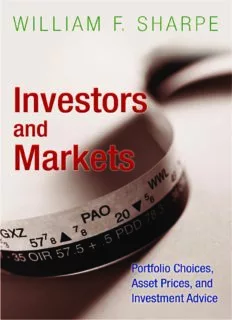
Investors and Markets: Portfolio Choices, Asset Prices, and Investment Advice PDF
Preview Investors and Markets: Portfolio Choices, Asset Prices, and Investment Advice
INVESTORS AND MARKETS PRINCETON LECTURES IN FINANCE Yacine Ait-Sahalia, Series Editor The Princeton Lectures in Finance, published by arrangement with the Bendheim Center for Finance of Princeton University, are based on annual lectures offered at Princeton University. Each year, the Bendheim Center invites a leading figure in the field of finance to deliver a set of lectures on a topic of major significance to researchers and professionals around the world. Stephen A. Ross, Neoclassical Finance William F. Sharpe, Investors and Markets: Portfolio Choices, Asset Prices, and Investment Advice INVESTORS AND MARKETS PORTFOLIO CHOICES, ASSET PRICES, AND INVESTMENT ADVICE William F. Sharpe This work is published by arrangement with the Bendheim Center for Finance of Princeton University princeton university press princeton and oxford Copyright © 2007 by Princeton University Press Published by Princeton University Press, 41 William Street, Princeton, New Jersey 08540 In the United Kingdom: Princeton University Press, 6 Oxford Street, Woodstock, Oxfordshire OX20 1TW All Rights Reserved Third printing, and first paperback printing, 2008 Paperback ISBN: 978-0-691-13850-3 The Library of Congress has cataloged the cloth edition of this book as follows Sharpe, William F. Investors and markets : portfolio choices, asset prices, and investment advice / William F. Sharpe. p. cm. Includes bibliographical references and index. ISBN-13: 978-0-691-12842-9 (hardcover : alk. paper) ISBN-10: 0-691-12842-1 (hardcover : alk. paper) 1. Portfolio management. 2. Securities—Prices. 3. Capital asset pricing model. 4. Investment analysis. 5. Investments. I. Title. HG4529.5.S53 2007 332.6—dc22 2006015387 British Library Cataloging-in-Publication Data is available This book has been composed in Goudy and Swiss 911 Extra Compressed by Princeton Editorial Associates, Inc., Scottsdale, Arizona Printed on acid-free paper. ∞ press.princeton.edu Printed in the United States of America 3 5 7 9 10 8 6 4 CONTENTS PREFACE vii ONE Introduction 1 TWO Equilibrium 9 THREE Preferences 35 FOUR Prices 63 FIVE Positions 111 SIX Predictions 129 SEVEN Protection 149 EIGHT Advice 185 REFERENCES 213 INDEX 215 PREFACE T HIS BOOK IS based on the Princeton University Lectures in Finance that I gave in May 2004. The invitation to present these lectures pro- vided me a chance to address old issues in new ways and to bring to- gether a number of interrelated topics in financial economics with an emphasis on individuals’ saving and investment decisions. I am grateful to Professor Yacine Ait-Sahalia of Princeton, the series editor, and to Peter Dougherty of Princeton University Press for inviting me to under- take this project and for giving me valuable advice throughout. This work follows a tradition with strong Princeton roots. In the first (2001) Princeton Lectures in Finance, Stephen Ross masterfully addressed the central issues associated with asset pricing. That work is now available as the first book in this series: Neoclassical Finance(Ross 2005). In 2001 Princeton University Press published the first edition of John Cochrane’s marvelous book, Asset Pricing(Cochrane 2001), which is fast be- coming a standard text for its target audience—“economics and finance Ph.D. students, advanced MBA students, and professionals with similar background.” My goal is to continue down the path set by Ross and Cochrane, using a somewhat different approach and providing several extensions. However, this book differs substantially from the work of Ross and Cochrane in both approach and motivation. I am primarily concerned with helping individual investors make good saving and investment decisions—usually with the assis- tance of investment professionals such as financial planners, mutual fund man- agers, advisory services, and personal asset managers. This requires more than just an understanding of the determinants of asset prices. But for many other applications in finance, it suffices to understand asset pricing. For example, a corporation desiring to maximize the value of its stock can, in principle, simply consider the pricing of the potential outcomes associated with its ac- tivities. A financial engineer designing a financial product may need only to determine a way to replicate the desired outcomes and compute the cost of doing so. Appropriately, Ross concentrated on the ability to price assets using only information about other assets’ prices in his first chapter: “No Arbitrage: The Fundamental Theorem of Finance.” The title of Cochrane’s book indicates a similar focus, as does his statement in the preface that “we now go to asset prices directly. One can then find optimal portfolios, but it is a side issue for the asset pricing question.” viii PREFACE However, to determine the best investment portfolio for an individual, one needs more than asset prices. To use the standard economic jargon, individuals should maximize expected utility, not just portfolio value. To do so efficiently requires an understanding of the ways in which asset prices reflect investors’ diverse situations and views of the future. I thus deal here with both asset pric- ing and portfolio choice. And, as will be seen, I treat them more as one subject than as two. Over the past year and a half I have benefited greatly from comments and suggestions made by a number of friends and colleagues. Without implicating any of them in the final results, I wish to thank Yacine Ait-Sahalia, Princeton University; Geert Bekaert, Columbia University; Phillip Dolan, Macquarie University; Peter Dougherty, Princeton University Press; Ed Fine, Financial Engines, Inc.; Steven Grenadier, Stanford University; Christopher Jones, Financial Engines, Inc.; Haim Levy, Hebrew University; Harry Markowitz, Harry Markowitz Associates; André Perold, Harvard University; Steven Ross, Massachusetts Institute of Technology; and Jason Scott, Jim Shearer, John Watson, and Robert Young, Financial Engines, Inc. Finally, I express my gratitude to my wife Kathy for her support and encour- agement. We are proof that a professional artist and a financial economist can live happily and productively together. INVESTORS AND MARKETS
Description: